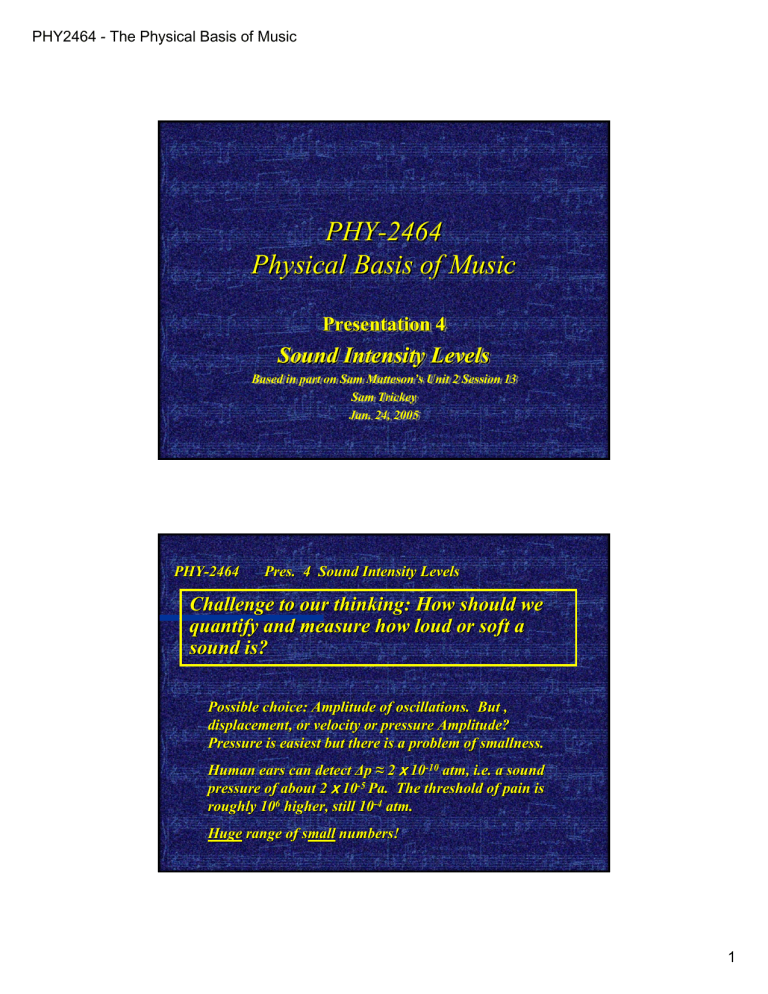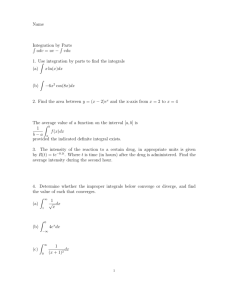PHY-2464 Physical Basis of Music PHY -
advertisement

PHY2464 - The Physical Basis of Music PHY -2464 PHY-2464 Physical Basis of Music Presentation Presentation 44 Sound Sound Intensity Intensity Levels Levels Based Based in in part part on on Sam Sam Matteson’s Matteson’s Unit Unit 22 Session Session 13 13 Sam Trickey Sam Trickey Jan. Jan. 24, 24, 2005 2005 PHYPHY-2464 Pres. 4 Sound Intensity Levels Challenge to our thinking: How should we quantify and measure how loud or soft a sound is? Possible choice: Amplitude of oscillations. But , displacement, or velocity or pressure Amplitude? Pressure is easiest but there is a problem of smallness. Human ears can detect ∆p ≈ 2 x 10-10 atm, i.e. a sound pressure of about 2 x 10-5 Pa. The threshold of pain is roughly 106 higher, still 10-4 atm. Huge range of small small numbers! 1 PHY2464 - The Physical Basis of Music PHYPHY-2464 Pres. 4 Sound Intensity Levels Since we know that sound moves membranes (drum heads, ear drum, microphone diaphragms, speaker cones, etc.) we might focus on energy instead of amplitude. Energy and amplitude aren’t the same. SHO again: at max extension or compression, U= Pot Energy = ½KA2 [A = amplitude] 3 Waves: AY=2 AX; UZ=2 UX then UY=4 UX ≠ UZ PHYPHY-2464 Pres. 4 Sound Intensity Levels However, the energies in question involve time. Example: measure total energy delivered at a point due to a steady source. The value simply grows with time. Not very useful. Power = ∆E/ ∆t = amount of energy / time interval of delivery As said on TV – But wait, there’s more ! 2 PHY2464 - The Physical Basis of Music PHYPHY-2464 Pres. 4 Sound Intensity Levels The “more”: Area! We really need to know how much energy is delivered to an area per time interval. This is defined to be INTENSITY I = Power/area = (Energy/time)(1/area) Example: 12 watts delivered to 0.6 m2 is I = 12/0.6 = 20 W/ m2 Intensity = constant x Amplitude2 So we still have the huge range of values problem PHYPHY-2464 Pres. 4 Sound Intensity Levels The Intensity of a sound wave is the energy radiated (or delivered) per unit time per unit area. [W/m2] FYI: Time Averaged Intensity < I > < I > = 0.0012 pmax2 ≈ pRMS2/400 The numerical values come from < I >= < p x udisplacement > = ½ pmax2/ ρv with [ p ] = [Pa] and [ I ] = [W/m2] and evaluating ρv for air at normal atmospheric pressure and room temperature density. By convention pRMS = pmax/√2 is what we mean by “the pressure” pressure” of a sine wave. 3 PHY2464 - The Physical Basis of Music PHYPHY-2464 Pres. 4 Sound Intensity Levels Dealing with big ranges of variation – Usually we don’t care about absolute sound pressures or intensities, only about their ratios, p1/p2 or I1/I2 (If we agree on some reference level, then everything else is ratios.) Logarithms are the arithmetic of ratios. PHYPHY-2464 Pres. 4 Sound Intensity Levels Mathematical Interlude Logarithms Log(N) Pick a positive number x. The power of 10 that will produce x when 10 is raised to that power is called the Logarithm (on the base 10) of the number x. Log (x) = L means that 10 L = x. 4 PHY2464 - The Physical Basis of Music PHYPHY-2464 Pres. 4 Sound Intensity Levels The Function“LOG (x)” Log(9) =0.95 Log(8) =0.90 Log(7) =0.85 Log(6) =0.78 Log(5) =0.70 Log(10) =1 Log(4) =0.60 Log(3) =0.48 Log(x) 1.0 .9 .8 .7 .6 .5 .4 .3 .2 .1 0 PHYPHY-2464 Log(2) =0.30 Log(1) =0 0 1 2 3 4 5 x 6 7 8 9 10 Pres. 4 Sound Intensity Levels Some Useful Facts about Logarithms: Log( a x b) = Log (a) + Log (b) Log( a / b) = Log (a) – Log (b) Log( x p) = p Log ( x ) Thus, in scientific notation: Log ( z x 10 n) = Log ( z ) + n 5 PHY2464 - The Physical Basis of Music PHYPHY-2464 Pres. 4 Sound Intensity Levels Sound Intensity Level: LI = SIL = 10 Log ( I / I threshold ). The Sound Intensity Level is 10 times the logarithm of the ratio of the intensity of a sound and the threshold of hearing. The units of SIL are deciBel or dB. I = I threshold 10 (SIL/10) PHYPHY-2464 Pres. 4 Sound Intensity Levels Definition (“convention”): I threshold = 10-12 W/m2 LI = SIL = 10 Log ( I / 10-12) = 10 Log I + 120 Actually measured: Sound PRESSURE Level Lp = SPL = 20 Log ( p/ pthreshold) =20 Log (p/2 x 10-5) ≈ 20 Log p + 94 6 PHY2464 - The Physical Basis of Music PHYPHY-2464 Pres. 4 Sound Intensity Levels Just Noticeable Difference (JND) is the limen of difference that elicits 75% correct answers in a Two Alternative Forced-Choice test (2AFC test). “limen” – term used in psychology to denote threshold “2AFC test” – “which lens is better, A or B?” Why 75%? PHYPHY-2464 Pres. 4 Sound Intensity Levels Why 75%? In 2 AFC • 50% correct means random choice • 100% means can always tell the difference. •Thus, 75% is halfway between random and certainty. 7 PHY2464 - The Physical Basis of Music PHYPHY-2464 Pres. 4 Sound Intensity Levels Empirically the limen of intensity is a ratio of about 1.26 This corresponds to a SIL shift of 1 dB. 10 Log( 1.26 ) = 1.0 . PHYPHY-2464 Pres. 4 Sound Intensity Levels Musical Dynamics Pianississimo: ppp really soft Pianissimo: pp very soft Piano: p soft Mezzopiano: mp medium soft Mezzoforte: mf medium loud Forte: f loud Fortissimo: ff very loud Fortississimo: fff really loud 50 dB 60 dB 65 dB 70 dB 76 dB 80 dB 85 dB 90 dB 8 PHY2464 - The Physical Basis of Music PHYPHY-2464 Pres. 4 Sound Intensity Levels Musical Dynamics: We have a problem – the composers mark the range can the performers deliver it? Is it possible for an arbitrary, un-amplified orchestral or band instrument to be played over a 40 dB range? Does a trained human voice have that dynamical range? PHYPHY-2464 Pres. 4 Sound Intensity Levels Combined Sound Levels: Two independent sources Add INTENSITIES (not SIL or SPL) Example Iclarinet= 2 x 106 Ithresh Iflute= 106 Ithresh Itot= 3 x 106 Ithresh SILflute = 10 log Iflute / Ithresh = 60 dB SILclarinet = 10 log Iclarinet / Ithresh = 63 dB SILtogether = 10 log Itot / Ithresh = 64.8 dB 9 PHY2464 - The Physical Basis of Music PHYPHY-2464 Pres. 4 Sound Intensity Levels Combined Sound Levels: Two sources at (or almost) same frequency: Interference must be taken into account Example : A1= 3A2 → I1= 9I2 → Itot = 10 I2 Independent: SILtot = SIL2 + 10 log 10 = SIL2 + 10 dB Constructive: AC= 3A2 + A2 = 4A2 → IC= 16 I2 SILC = SIL2 + 10 log 16 = SIL2 + 12 dB Destructive: AD= 3A2 - A2 = 2A2 → ID= 4 I2 SILD = SIL2 + 10 log 4 = SIL2 + 6 dB PHYPHY-2464 Pres. 4 Sound Intensity Levels Summary: •The objective sound level is measured as SIL or SPL in dB. •SIL = 10 Log (I /Ithreshold) •SPL = 20 Log (p/pthreshold) •0 dB corresponds to an intensity of 1 pW/m2. • Add intensities to get combined SIL; beware interference. • Remark - Un-amplified orchestral music rarely exceeds 90 dB; the threshold of pain is 120 dB. 10





